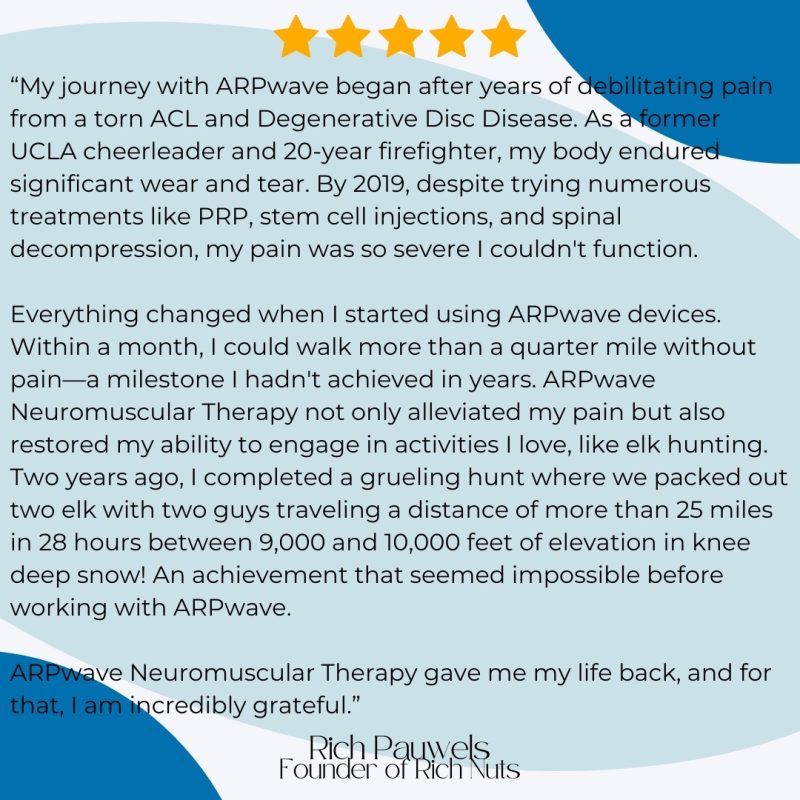RxBlack
ARPwave’s premier therapy device, and is revered within elite athletic communities.
FlexDoctor
Integrates our revolutionary waveform into a portable, handheld device,
offering convenient pain reduction with just the push of a button.

The anterior cruciate ligament — commonly known as the ACL — may be small, but it plays a massive role in the function and stability of the knee. If you’ve ever torn it, know someone who has, or is active in sports; chances are you’ve heard just how serious an ACL injury can be.
In this guide, we’ll walk through everything you need to know about the ACL — what it is, how injuries occur, symptoms to watch for, and treatment options. Most importantly, we’ll show how ARPwave Neuro Therapy can dramatically accelerate recovery, reduce pain, and help you return to peak performance faster than traditional rehab alone.
The ACL is one of four major ligaments in the knee. It connects the thigh bone (femur) to the shin bone (tibia) and is located deep within the joint. Working alongside the posterior cruciate ligament (PCL), the ACL helps stabilize the knee during movement — especially twisting, pivoting, jumping, and quick direction changes.
This ligament is crucial in everyday activities like walking and running, but it’s even more important during high-demand sports like soccer, basketball, football, and skiing. Unfortunately, this makes it especially vulnerable to injury in athletes.
ACL injuries can occur in a variety of ways, but they’re most often the result of non-contact movements. This means the ligament tears not from a collision or hit, but from how the body moves. Common causes include:
Women are more prone to ACL injuries due to differences in anatomy, muscle strength, and hormonal factors. Young athletes are also at higher risk, especially in sports that involve jumping and cutting.
When the ACL is torn, most people report a distinctive “pop” in the knee at the moment of injury. Other classic signs include:
While not every knee injury involves a torn ACL, these symptoms are strong indicators and should be evaluated by a medical professional as soon as possible.
A healthcare provider — often an orthopedic specialist — will perform a physical exam to test the knee’s stability. They may also order imaging tests such as:
Prompt and accurate diagnosis is crucial. A delayed or missed diagnosis can lead to further joint damage, especially to the meniscus or cartilage.
Rehabilitation is essential, regardless of surgery being involved in the patient’s treatment plan. Recovery from an ACL tear is a gradual process that usually spans 6 to 12 months, depending on the individual and the demands of their lifestyle or sport.
A Typical ACL Rehab Timeline:
Skipping rehab or returning to sport too early dramatically increases the risk of re-injury.
Despite the long and demanding process of Standard ACL Recovery, innovative technologies like ARPwave Neuro Therapy are changing the game by significantly reducing recovery time and improving long-term outcomes.
What Is ARPwave Therapy?
ARPwave stands for Accelerated Recovery Performance, a breakthrough in neuro-muscular therapy that uses electrical stimulation combined with active movement. Unlike traditional e-stim or TENS units, ARPwave targets the neurological origin of injury and pain, not just the symptoms.
It works by:
How ARPwave Helps ACL Recovery
Traditional ACL treatment — whether surgical or non-surgical — typically relies on rest, bracing, and progressive physical therapy to rebuild strength and stability over several months. In the early stages, recovery is often passive, with limited movement to avoid aggravating the injury. Muscle reactivation can be slow, and compensation patterns may develop, increasing the risk of re-injury. In contrast, ARPwave therapy directly targets the nervous system, not just the muscles or joints. It actively re-educates the body’s movement patterns from day one, using electrical stimulation to immediately reactivate weakened muscles, reduce inflammation, and accelerate tissue healing. This approach enables faster progression to weight-bearing and dynamic movement, dramatically reducing recovery time — often cutting it in half — while improving long-term outcomes and functional strength.
After an ACL injury or reconstruction surgery, the surrounding muscles often shut down or weaken — especially the quads, hamstrings, and glutes. ARPwave helps:
In many cases, patients using ARPwave report returning to normal activity in half the time compared to traditional rehab programs — sometimes as quickly as 3 to 6 months post-op (depending on the case and compliance with therapy).

If you’re recovering from an ACL tear or surgery and want to explore a faster, smarter recovery path, ARPwave therapy may be the solution you’ve been looking for.

While you can’t completely eliminate the risk, preventive training can significantly reduce the chance of an ACL injury — particularly in young athletes and females.
Programs like FIFA 11+ or PEP (Prevent injury, Enhance Performance) include exercises that focus on:
These training methods not only help prevent injuries but also enhance performance.
If you’ve had a knee injury and notice any of the following signs, it’s time to get it checked:
Early evaluation leads to better outcomes — and potentially avoids complications down the road.
The ACL is a vital component of knee stability and function and while ACL injuries can be physically and mentally challenging, advancements in recovery technology are changing the game. Traditional rehab methods are effective but often slow and limited in their ability to fully restore neuromuscular function. ARPwave therapy offers a powerful alternative — or complement — by accelerating muscle activation, restoring proper movement patterns, and significantly shortening recovery timelines. Whether you’re recovering from a partial tear, undergoing ACL reconstruction, or looking to return to sport safely and efficiently, ARPwave provides a smarter, faster path to full recovery. If you’re serious about getting back to peak performance, exploring ARPwave could be the key to unlocking a more complete and confident return.
Leave your details below and one of our operators will contact you.